Finding the perfect hairstyle for your child’s natural hair can be both exciting and challenging, but cornrows offer a beautiful solution that combines style, protection, and practicality.
The 30 Best Cornrow Hairstyles for Kids with Natural Hair showcases a diverse collection of braiding patterns that celebrate the natural texture and versatility of children’s hair while keeping it healthy and manageable.
Cornrows have been a cherished tradition in African and African American culture for centuries, providing not only aesthetic appeal but also serving as a protective style that minimizes daily manipulation and promotes hair growth.
This comprehensive guide walks you through thirty stunning cornrow variations, from simple straight-back designs perfect for active toddlers to intricate geometric patterns that make a bold statement for older children.
Whether you’re preparing for school pictures, a special event, or simply want a low-maintenance style that lasts for weeks, these cornrow hairstyles offer something for every personality, hair length, and skill level.
You’ll discover classic designs that never go out of style, trendy modern twists on traditional patterns, and creative combinations that incorporate beads, colors, and accessories to make each look uniquely special.
Each hairstyle in this collection has been selected for its ability to protect delicate young hair while allowing children to express their individuality and cultural heritage with confidence and pride.
Contents
- 1 1. Classic Straight-Back Cornrows
- 2 2. Side-Swept Cornrows
- 3 3. Zigzag Cornrows
- 4 4. Heart-Shaped Cornrow Design
- 5 5. Cornrow Mohawk Style
- 6 6. Feed-In Cornrows
- 7 7. Curved Cornrow Patterns
- 8 8. Cornrows with Beads
- 9 9. Triangle Box Cornrows
- 10 10. Halo Cornrow Braid
- 11 11. Small Cornrows All Over
- 12 12. Cornrow Ponytail
- 13 13. Cornrows with Loose Ends
- 14 14. Stitch Braids
- 15 15. Cornrow Updo
- 16 16. Crisscross Cornrows
- 17 17. Cornrows with Hair Extensions
- 18 18. Fulani Braids
- 19 19. Lemonade Braids
- 20 20. Cornrow Pigtails
- 21 21. Goddess Cornrows
- 22 22. Tribal Cornrow Patterns
- 23 23. Cornrow Bob
- 24 24. Mixed Size Cornrows
- 25 25. Cornrows with Twists
- 26 26. Jumbo Cornrows
- 27 27. Cornrows with Bantu Knots
- 28 28. Cornrow Crown with Center Puff
- 29 29. Ladder Braid Cornrows
- 30 30. Cornrows with Colored Extensions
- 31 Styling and Maintenance Tips for Cornrow Hairstyles
- 32 Health Considerations for Children’s Cornrows
- 33 Conclusion
1. Classic Straight-Back Cornrows
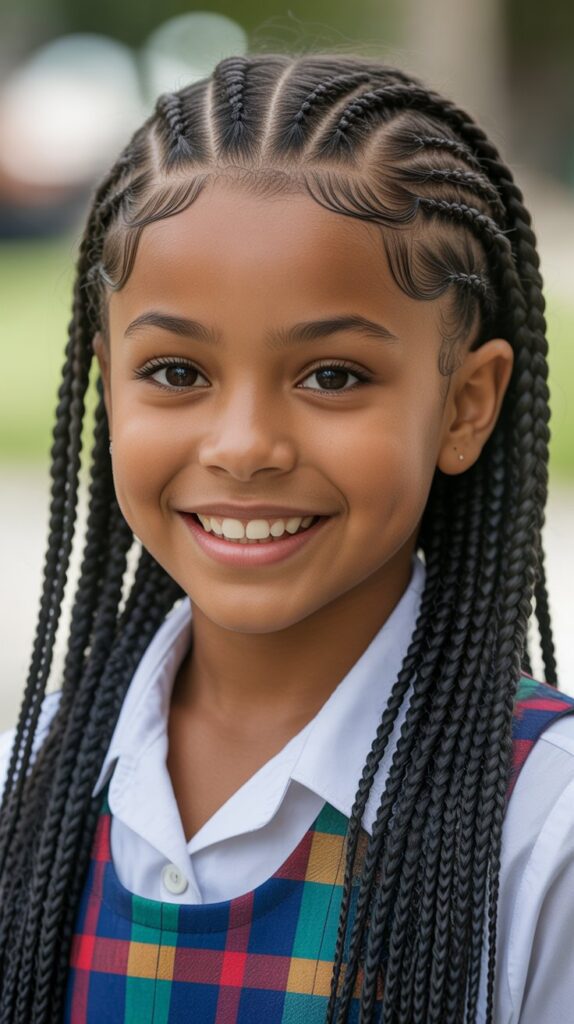
Classic straight-back cornrows are the foundation of protective styling for children, featuring neat parallel rows that run from the hairline to the nape of the neck.
This timeless design works beautifully for kids of all ages and requires minimal styling products, making it ideal for parents seeking a clean, professional look that withstands playground activities and sports.
Key Features:
- Duration: Lasts 2-4 weeks with proper care
- Best For: All hair types and lengths
- Maintenance Level: Low
- Age Suitability: 3 years and up
Benefits of straight-back cornrows:
- Keeps hair completely off the face for school and activities
- Promotes healthy hair growth by reducing daily manipulation
- Easy to maintain with simple nighttime wrapping routines
- Creates a neat appearance that parents and teachers appreciate
- Serves as a protective style during seasonal transitions
Styling tips:
- Apply a light moisturizing cream before braiding to prevent dryness
- Keep rows evenly spaced for a balanced, symmetrical appearance
- Use edge control for smooth, sleek hairlines
- Wrap hair with a silk or satin scarf at night to preserve the style
- Refresh edges weekly with a small amount of holding gel
2. Side-Swept Cornrows
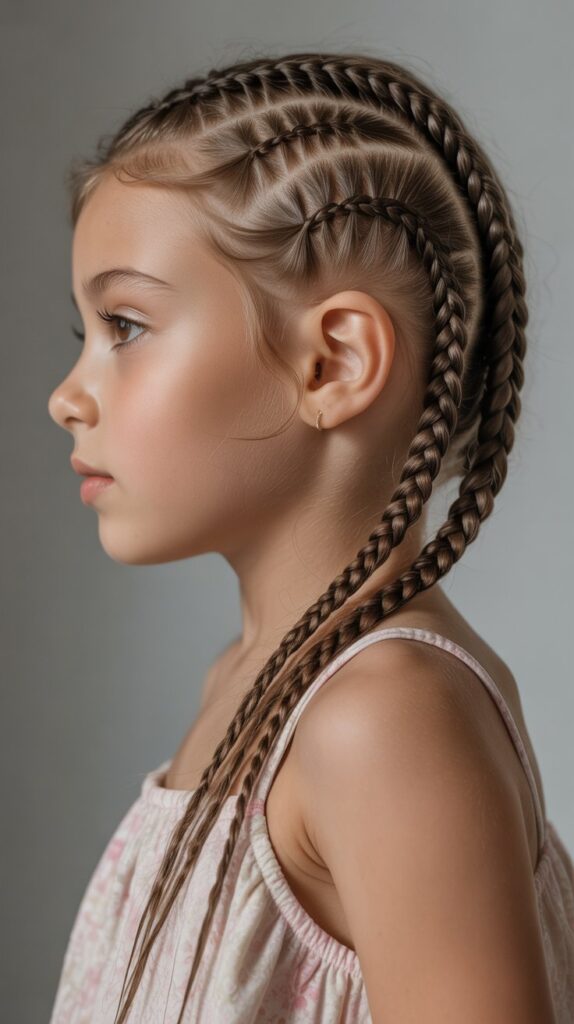
Side-swept cornrows create an elegant asymmetrical look by directing all the braids to one side of the head, offering a sophisticated twist on traditional patterns.
This style adds dimension and visual interest while maintaining the protective benefits of cornrowing, making it perfect for children who want something different from standard straight-back designs.
Style variations:
- All braids swept to the left or right side
- Creates volume and texture on one side
- Can be gathered into a side ponytail or bun
- Works exceptionally well with medium to long hair lengths
- Pairs beautifully with decorative hair accessories
Maintenance requirements:
- Requires slightly more careful sleeping arrangements to avoid flattening
- Benefits from daily light misting with water and leave-in conditioner
- May need edge touch-ups every 5-7 days
- Should be re-braided every 3-4 weeks
3. Zigzag Cornrows

Zigzag cornrows transform traditional straight lines into playful patterns that create visual movement and artistic flair across the scalp.
This geometric design appeals to creative children and parents who want to showcase braiding artistry while maintaining the protective qualities of cornrow styling.
Design elements:
- Creates alternating angular patterns across the head
- Adds dimension and texture to the overall appearance
- Requires advanced braiding skills or professional styling
- Makes a bold statement for special occasions
- Can be combined with straight sections for contrast
Technical considerations:
- Takes longer to install than straight-back cornrows (3-5 hours)
- Requires precise parting for clean zigzag definition
- Best suited for hair that is at least 3-4 inches long
- May be challenging for very young children to sit through
4. Heart-Shaped Cornrow Design
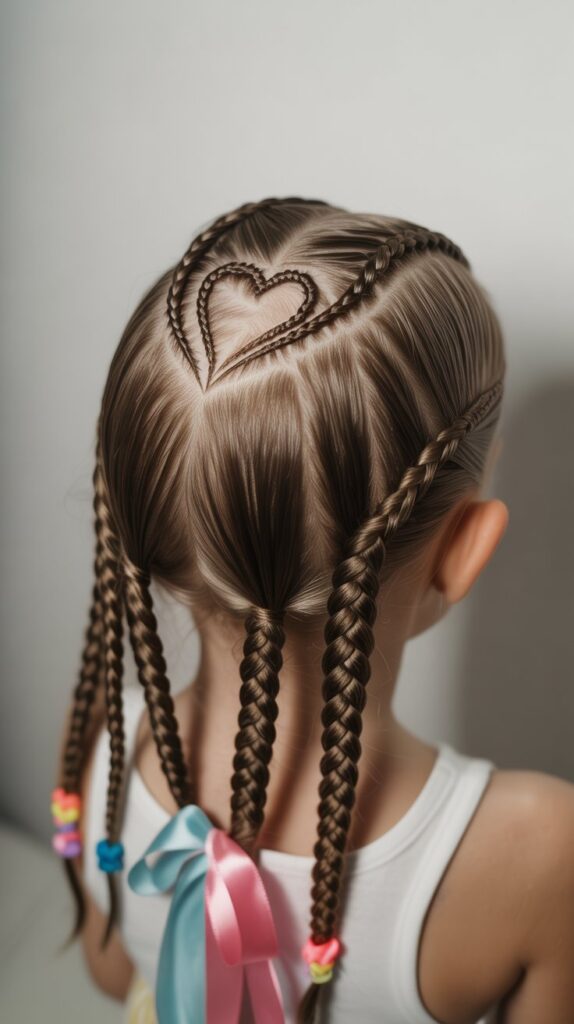
Heart-shaped cornrows create an adorable focal point by forming a heart pattern at the crown or back of the head, surrounded by complementary braiding designs.
This romantic and playful style is particularly popular for Valentine’s Day, birthday celebrations, or whenever your child wants to showcase something extra special.
Design specifications:
- Heart formation typically placed at the crown or upper back area
- Surrounding braids can be straight, curved, or combined patterns
- Requires skilled braiding to achieve symmetrical heart shape
- Works best with medium to thick hair density
- Perfect for photo opportunities and special events
Occasions perfect for heart designs:
- Valentine’s Day celebrations at school
- Birthday parties and family gatherings
- Dance recitals and performances
- Holiday portraits and professional photos
- First day of school or special achievements
5. Cornrow Mohawk Style
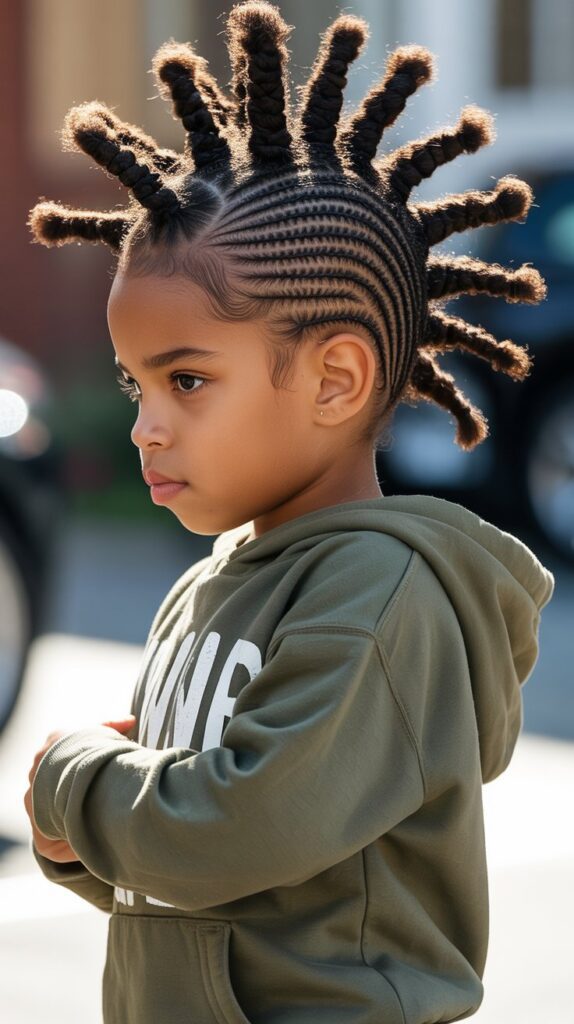
The cornrow mohawk creates an edgy, fashion-forward look by braiding the sides close to the scalp while leaving the center section raised or styled upward.
This bold design appeals to confident kids who want to express their unique personality while parents appreciate the protective nature and longevity of the style.
Construction method:
- Sides are braided in tight, flat cornrows directed downward or backward
- Center section can be left loose, twisted, or braided into raised patterns
- Creates dramatic height and visual contrast
- Offers versatility in how the center section is finished
- Can be adapted for different hair lengths and textures
Styling the center section:
- Loose curls or twists for maximum volume and texture
- Braided into a raised mohawk ridge
- Styled into multiple small buns along the centerline
- Adorned with colorful elastics, beads, or accessories
- Can be changed daily without disturbing the side cornrows
6. Feed-In Cornrows

Feed-in cornrows use a gradual hair-adding technique that creates a natural-looking, flatter start at the hairline before building to fuller braids.
This modern braiding method reduces tension on the edges and scalp, making it healthier for children’s delicate hair follicles while achieving a seamless, professional appearance.
Technical advantages:
- Significantly reduces tension and pulling on the hairline
- Creates a more natural-looking start without visible bulkiness
- Promotes healthier edges and prevents traction alopecia
- Results in lighter-weight braids that are more comfortable
- Achieves a sleeker, more polished overall appearance
Health benefits for children:
- Minimizes stress on developing hair follicles
- Reduces headaches and discomfort from tight braiding
- Allows better scalp circulation and health
- Decreases risk of hair breakage at the roots
- Suitable for children with sensitive scalps
7. Curved Cornrow Patterns
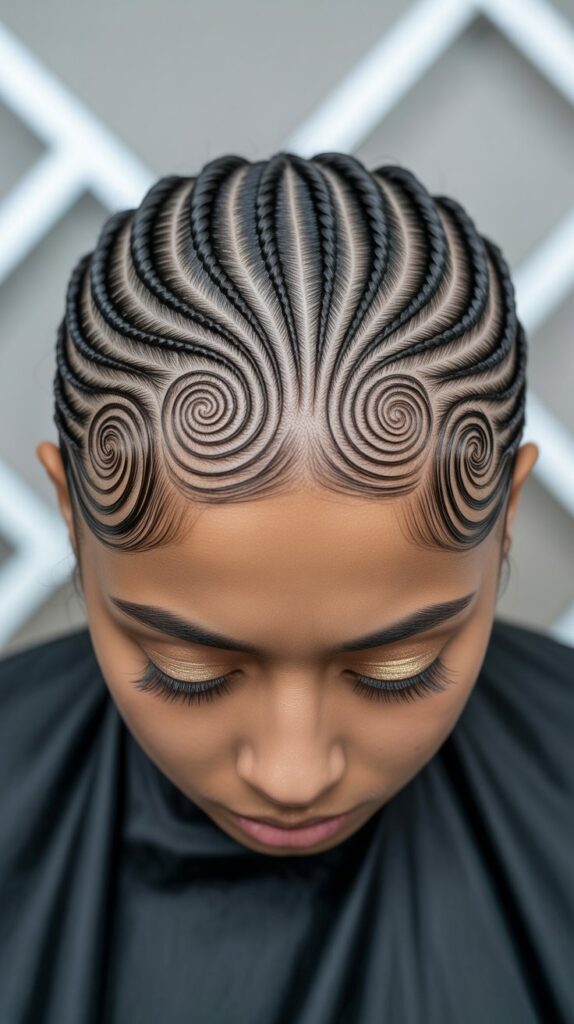
Curved cornrows follow flowing, arc-shaped pathways across the scalp instead of straight lines, creating elegant and feminine designs with graceful movement.
These artistic patterns add sophistication to protective styling and can be customized into countless configurations from simple waves to complex swirling designs.
Popular curved patterns:
- Gentle S-curves running from front to back
- Circular patterns radiating from a center point
- Wave-like designs across one side
- Spiral formations creating visual rotation
- Combination of curves with strategic straight sections
Artistic considerations:
- Requires advanced parting and braiding skills
- Takes longer to complete than straight designs (4-6 hours)
- Showcases the braider’s artistic vision and technical ability
- Creates stunning visual impact for photographs
- Best appreciated when hair is freshly done
8. Cornrows with Beads

Adding beads to cornrows transforms a classic protective style into a colorful, playful expression of childhood personality and creativity.
Beads provide cultural connection, decorative flair, and a satisfying auditory element that many children love, while also helping to secure the ends of braids and add weight for better longevity.
Bead selection guide:
- Plastic pony beads: Lightweight, colorful, affordable, and kid-friendly
- Wooden beads: Natural aesthetic, slightly heavier, earth-tone options
- Metal beads: Durable and stylish but heavier for young children
- Glass beads: Beautiful but breakable, best for older kids
- Cultural beads: Traditional African beads for heritage connection
Application methods:
- Threading individual beads onto braid ends
- Creating patterns with alternating colors
- Graduating bead sizes from large to small
- Spacing beads evenly along the length of braids
- Securing with small elastics to prevent slipping
Safety considerations:
- Ensure beads have smooth edges without sharp points
- Avoid beads small enough to be choking hazards for toddlers
- Check that beads aren’t too heavy for the child’s comfort
- Remove beads before swimming or vigorous sports activities
- Inspect regularly for cracks or damage that could catch hair
9. Triangle Box Cornrows
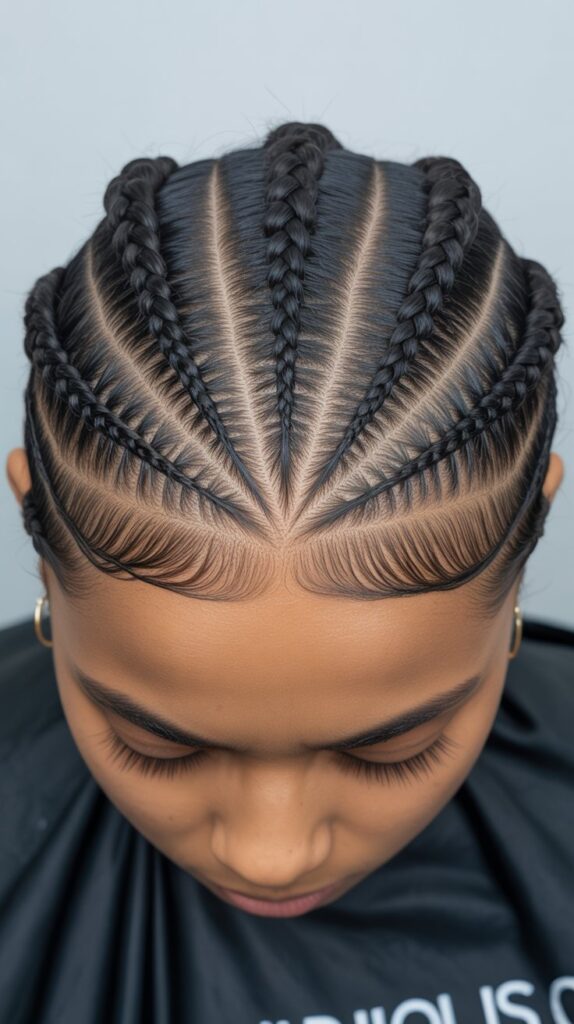
Triangle box cornrows create geometric precision by parting the hair into triangular sections before braiding, offering a modern architectural approach to traditional cornrowing.
This eye-catching design showcases clean angles and structured patterns that stand out in any setting while providing excellent scalp access for moisturizing.
Geometric benefits:
- Creates unique angular patterns across the scalp
- Allows for creative color placement in the partings
- Provides excellent definition and visual interest
- Makes sectioning visible as part of the overall design
- Offers flexibility in braid direction and pattern
Parting techniques:
- Use the pointed end of a rattail comb for precise triangle creation
- Alternate triangle directions for a tessellated effect
- Maintain consistent triangle size for uniform appearance
- Apply edge control along partings for clean definition
- Can combine triangles with other geometric shapes
10. Halo Cornrow Braid
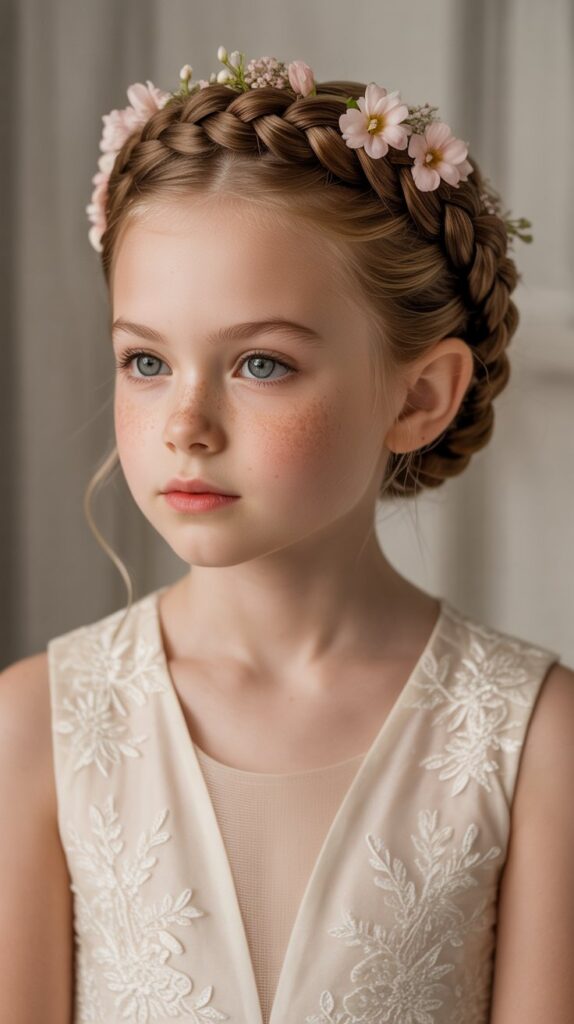
The halo cornrow braid circles around the head like a crown, creating an angelic and regal appearance that’s perfect for formal occasions and celebrations.
This protective style keeps hair completely secured while framing the face beautifully and can be adorned with flowers, ribbons, or left elegantly simple.
Construction approach:
- Begins at the nape or one side of the head
- Braids continuously around the perimeter
- Can be a single thick braid or multiple thinner rows
- Requires careful tension management to maintain circular shape
- Ends are tucked and secured discretely
Ideal occasions:
- Weddings and formal ceremonies
- Religious celebrations and confirmations
- School performances and recitals
- Holiday gatherings and portraits
- Special cultural events and festivals
Styling enhancements:
- Weave fresh or artificial flowers into the halo
- Add decorative ribbon threaded through the braid
- Incorporate gold or silver hair jewelry
- Place small pearl or crystal pins along the crown
- Keep center hair styled in curls, twists, or left natural
11. Small Cornrows All Over
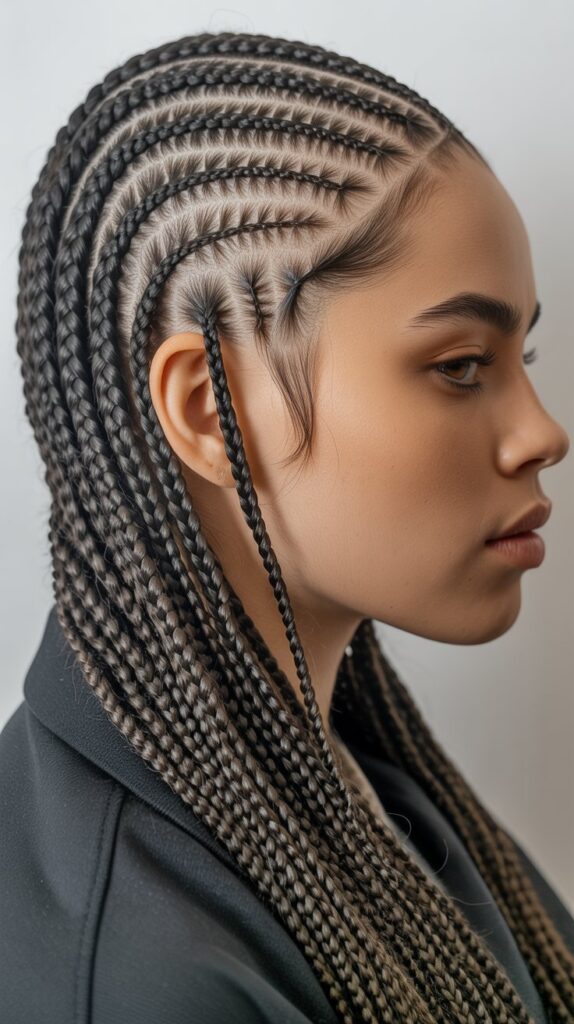
Creating numerous small cornrows all over the head produces a textured, intricate appearance with exceptional longevity and scalp health benefits.
This labor-intensive style requires patience during installation but rewards with 4-6 weeks of low-maintenance wear, making it ideal for busy families and active children.
Installation specifications:
- Typically consists of 20-40+ individual cornrows
- Each braid is pencil-thin or smaller in diameter
- Installation time ranges from 5-8 hours
- Requires professional skill for uniform sizing
- Best suited for patient children who can sit still
Longevity advantages:
- Lasts significantly longer than larger cornrows (4-6 weeks)
- Maintains neater appearance with less frizzing
- Provides maximum scalp access for moisturizing
- Reduces need for frequent restyling
- Economical choice for extended wear
Daily maintenance routine:
- Spray with water and leave-in conditioner mixture daily
- Apply lightweight oil directly to scalp between rows
- Sleep with satin or silk bonnet or pillowcase
- Avoid heavy products that cause buildup
- Refresh edges weekly with gentle styling gel
12. Cornrow Ponytail
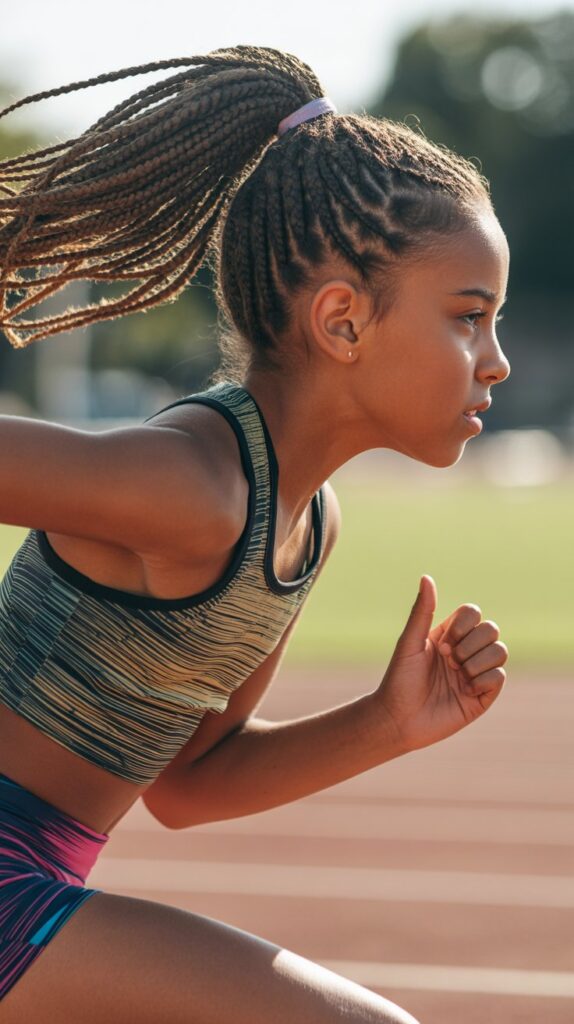
The cornrow ponytail combines the security of braided sides or crown with the versatility of gathered hair at the back or top.
This hybrid style offers the best of both worlds—protective braiding where needed and flexible styling options for the ponytail portion.
Design variations:
- High ponytail with cornrowed sides and back
- Low ponytail with cornrows along the crown
- Side ponytail with directional cornrow flow
- Center part with cornrows feeding into back ponytail
- Multiple small cornrows gathering into a sleek pony
Ponytail styling options:
- Leave ponytail hair in natural curls or coils
- Twist the ponytail into a rope braid
- Create a braided or twisted bun
- Add colorful elastics, scrunchies, or bows
- Wrap a small section of hair around the elastic base
Activity suitability:
- Excellent for sports and athletic activities
- Keeps hair secure during dance and gymnastics
- Perfect for swimming when ponytail is also braided
- Suitable for everyday school wear
- Comfortable for sleeping with proper wrapping
13. Cornrows with Loose Ends
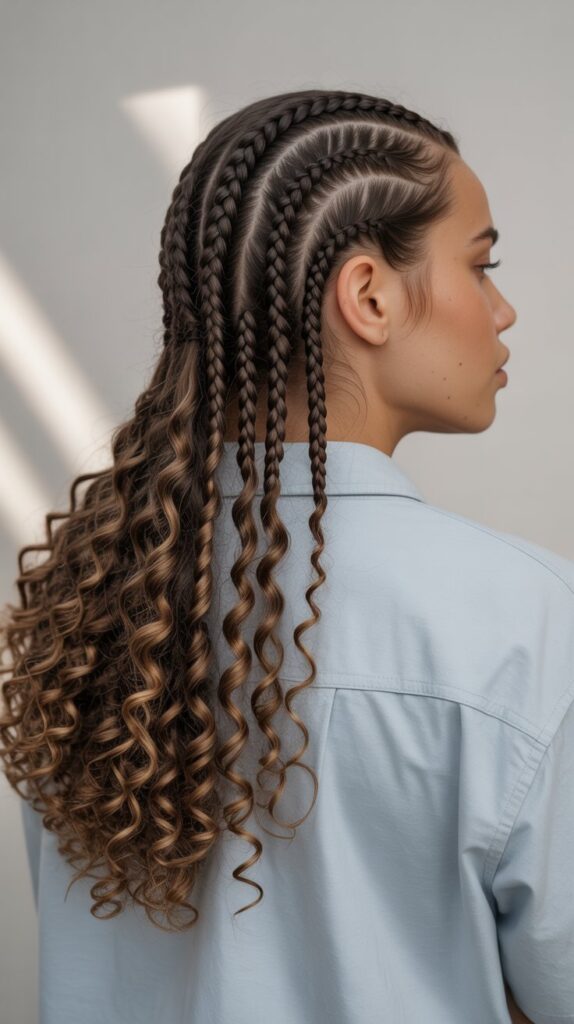
Braiding cornrows partway down and leaving the ends loose creates a flowing, dynamic style that combines protective braiding with natural hair texture.
This approach works beautifully for children with longer hair who want to show off their natural curls, coils, or waves while still benefiting from scalp protection.
Length requirements:
- Works best with hair at least 6-8 inches long
- Longer hair creates more dramatic flowing effect
- Can be adapted for medium-length hair with shorter loose sections
- Natural curl pattern becomes a feature of the style
- Requires healthy ends for best appearance
Styling the loose sections:
- Apply curl-defining cream to enhance natural pattern
- Twist or braid loose ends for variety
- Add hair accessories like clips or ribbons
- Create bantu knots with the loose ends
- Leave completely natural for maximum volume
Maintenance requirements:
- Loose ends require daily moisturizing and detangling
- May need to redefine curls every 2-3 days
- Protect loose hair during sleep with pineapple method
- Trim ends if necessary before installation for health
- Can re-braid loose sections if they become too tangled
14. Stitch Braids

Stitch braids create a distinctive horizontal or diagonal pattern within each cornrow by using a precise braiding technique that produces a stitched appearance.
This trendy style has gained popularity for its clean, modern aesthetic and the visual interest created by the defined stitch marks along each braid.
Technical characteristics:
- Requires pulling small horizontal sections across the braid
- Creates a raised, textured pattern within the cornrow
- Demands advanced braiding skills and patience
- Results in highly defined, uniform stitching
- Takes longer than traditional cornrowing (4-6 hours)
Visual impact:
- Produces striking definition that photographs beautifully
- Creates texture and dimension within each row
- Makes even simple patterns look more elaborate
- Highlights the braider’s technical skill
- Stays defined longer than regular cornrows
Popular stitch patterns:
- Straight horizontal stitches for classic look
- Diagonal stitches for dynamic movement
- Alternating stitch directions between rows
- Combination with curved cornrow patterns
- Integration with geometric designs
15. Cornrow Updo
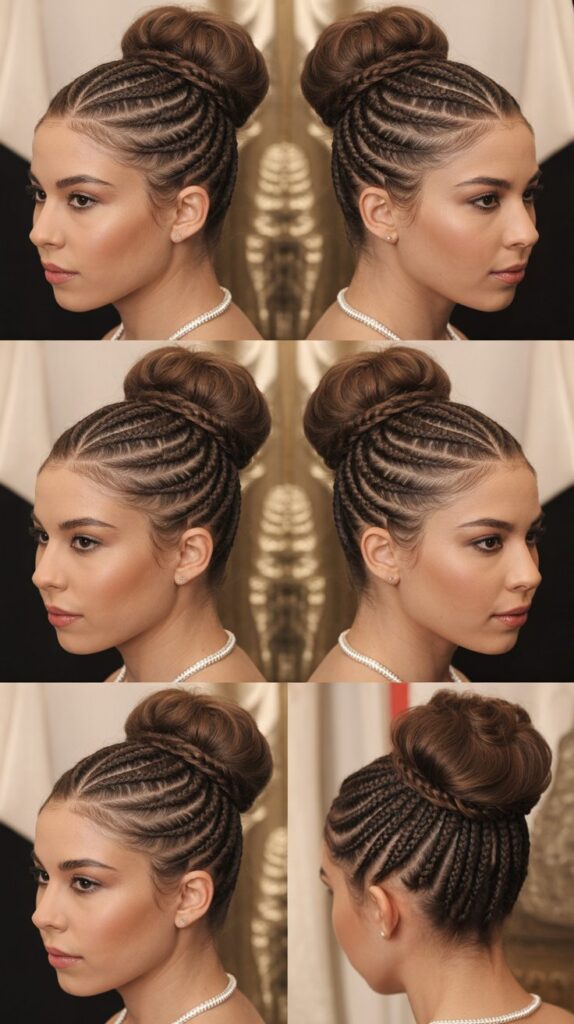
Cornrow updos elegantly gather braids into sophisticated high styles, creating formal and polished looks suitable for special occasions.
This versatile category includes various techniques for pinning, twisting, and arranging cornrows into beautiful elevated designs that keep hair completely off the neck and shoulders.
Updo style variations:
- Braids pinned into a circular crown formation
- Twisted and tucked into a low bun at the nape
- Gathered and wrapped into a high top knot
- Arranged into a braided bun or chignon
- Configured into decorative pinned patterns
Occasion appropriateness:
- Weddings as flower girl or junior bridesmaid
- Formal family portraits and photography sessions
- Religious ceremonies and celebrations
- Dance performances and ballet recitals
- School formal events and graduations
Securing the updo:
- Use bobby pins color-matched to hair for invisibility
- Anchor larger sections with hair pins
- Avoid excessive pinning that causes discomfort
- Test security by gentle shaking before event
- Bring emergency pins to events for touch-ups
16. Crisscross Cornrows
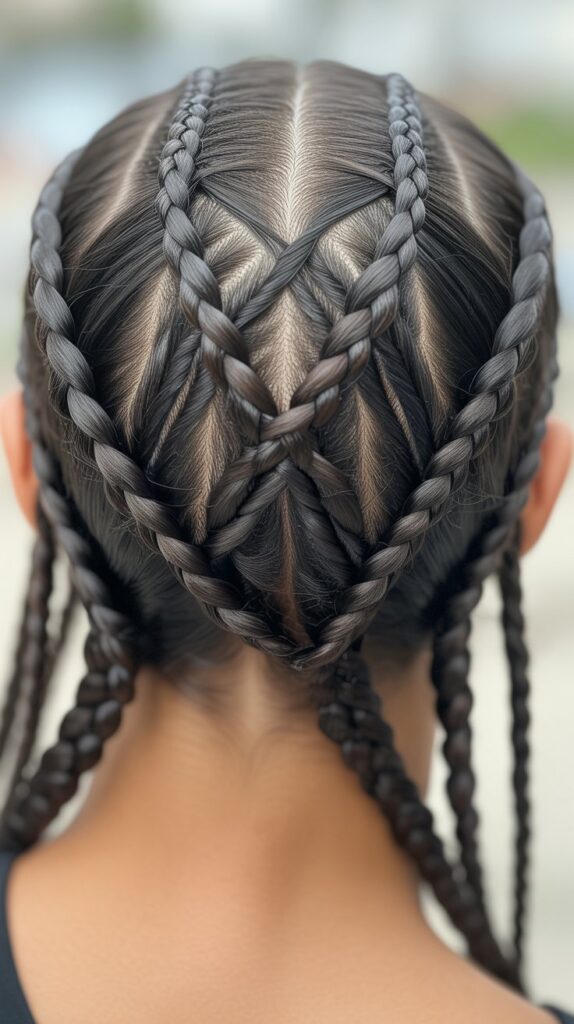
Crisscross cornrows create dynamic intersecting patterns where braids overlap and weave across each other, producing a basket-weave or lattice effect.
This complex design showcases advanced braiding artistry and creates stunning visual depth that elevates protective styling to an art form.
Pattern complexity:
- Requires careful planning of braid pathways
- Involves alternating over-under crossing techniques
- Creates three-dimensional visual effects
- Demands experienced braiding skills
- Takes significantly longer than standard cornrows (5-7 hours)
Design planning:
- Map out the crossing pattern before starting
- Maintain consistent braid thickness for uniformity
- Consider symmetry for balanced appearance
- Plan crossing points strategically for visual impact
- Adapt pattern complexity to child’s sitting tolerance
Maintenance challenges:
- More difficult to moisturize at crossing points
- May have slightly shorter wear time due to complexity
- Requires extra care when wrapping for sleep
- Refreshing edges becomes more intricate
- Professional removal recommended to avoid tangling
17. Cornrows with Hair Extensions
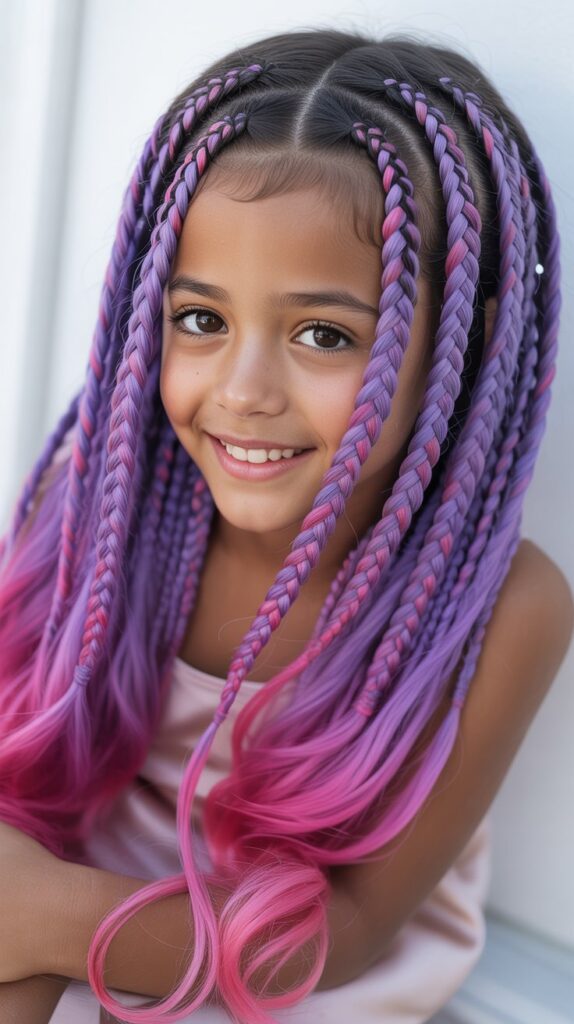
Adding hair extensions to cornrows allows for longer, fuller braids with more styling versatility and creative color options.
This technique works particularly well for children with shorter natural hair who desire length, or those wanting to experiment with bold colors without permanent dye.
Extension types suitable for kids:
- Kanekalon synthetic braiding hair: Affordable, lightweight, widely available
- X-pression braiding hair: Pre-stretched, soft texture, less weight
- Human hair extensions: Natural appearance, expensive, premium option
- Colored extensions: Fun colors without chemical processing
- Ombre extensions: Gradual color transition effects
Application method:
- Extensions are fed into braids using feed-in technique
- Reduces tension compared to bulky starting points
- Allows gradual thickness building
- Creates seamless blending with natural hair
- Should not be too heavy for child’s comfort
Length considerations:
- Consider child’s height and activity level
- Very long extensions may interfere with play
- Medium length (shoulder to mid-back) most practical
- Can always trim extensions if too long
- Test weight tolerance during installation
Color safety:
- Extensions avoid chemical dye damage to natural hair
- Temporary color experimentation without commitment
- Can mix multiple colors for custom effects
- Easily removed when child tires of color
- School dress codes should be verified first
18. Fulani Braids
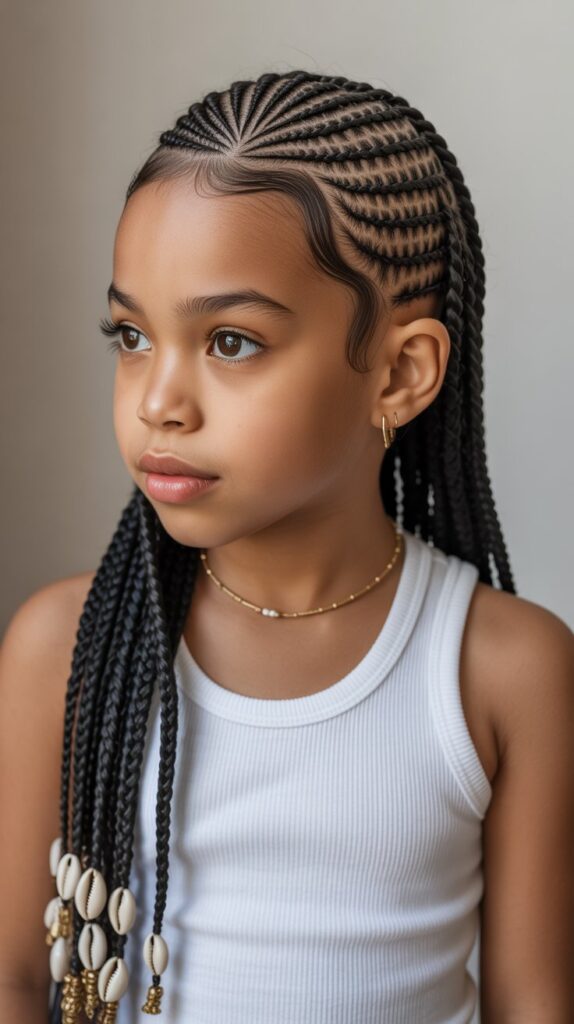
Fulani braids are a traditional African hairstyle featuring distinctive characteristics including a center cornrow, side cornrows, and decorative beads or cowrie shells.
This culturally significant style connects children to their heritage while creating a beautiful, symmetrical appearance that’s both protective and stylish.
Defining characteristics:
- Single or multiple cornrows down the center part
- Thin to medium cornrows along the sides
- Traditional adornment with beads and accessories
- Often includes braided or twisted sides
- May incorporate wrapping techniques
Cultural significance:
- Originates from the Fulani people of West Africa
- Carries historical and cultural heritage value
- Teaches children about their ancestral traditions
- Creates connection to African identity
- Represents continuation of braiding traditions
Traditional accessories:
- Cowrie shells: Symbol of fertility and prosperity
- Gold or metallic beads: Represent wealth and status
- Leather or fabric wrapping: Traditional decoration method
- Coins or medallions: Cultural significance in various regions
- Natural materials: Seeds, wood, or bone beads
Modern adaptations:
- Contemporary bead colors and materials
- Simplified patterns for younger children
- Shorter wear time adaptations
- Integration with modern hair jewelry
- Fusion with other braiding styles
19. Lemonade Braids

Lemonade braids, popularized by Beyoncé, feature long cornrows swept dramatically to one side, creating a bold asymmetrical look.
This trendy style has become iconic in modern hair culture and offers a glamorous option for children wanting to emulate contemporary beauty standards while maintaining hair health.
Style specifications:
- All cornrows directed to one side of the head
- Can vary from thin to thick braids
- Typically extends past shoulders when using extensions
- Creates dramatic side-swept silhouette
- Often incorporates feeding technique for natural appearance
Best suited for:
- Children with confidence and personality to match the bold style
- Special events, photoshoots, and celebrations
- Older children who appreciate fashion trends
- Those with medium to thick hair density
- Kids who want a celebrity-inspired look
Styling considerations:
- Requires careful sleeping positioning to maintain appearance
- May need more frequent edge touch-ups on the exposed side
- Consider child’s dominant hand side for practical sweeping
- Can add accessories on the visible side for extra flair
- Works beautifully for formal portraits and occasions
20. Cornrow Pigtails

Cornrow pigtails combine protective braiding on the scalp with dual ponytails or braids, creating a youthful and playful appearance.
This adorable style is perfect for younger children and offers practical functionality for active play while maintaining a sweet, age-appropriate aesthetic.
Configuration options:
- Cornrows on sides meeting at two separate ponytails
- Center part with cornrows leading to left and right pigtails
- Multiple small cornrows gathered into two sections
- Cornrowed crown with loose pigtails below
- Feed-in cornrows creating seamless pigtail integration
Age appropriateness:
- Especially popular for toddlers through elementary age
- Creates innocent, childlike charm
- Easy for children to manage independently as they age
- Comfortable for napping and play
- Allows for daily style variations in the pigtail sections
Pigtail placement:
- High pigtails for sporty, energetic look
- Low pigtails for classic, traditional appearance
- Angled pigtails for unique positioning
- Asymmetrical heights for playful variation
- Behind-the-ear placement for face framing
21. Goddess Cornrows
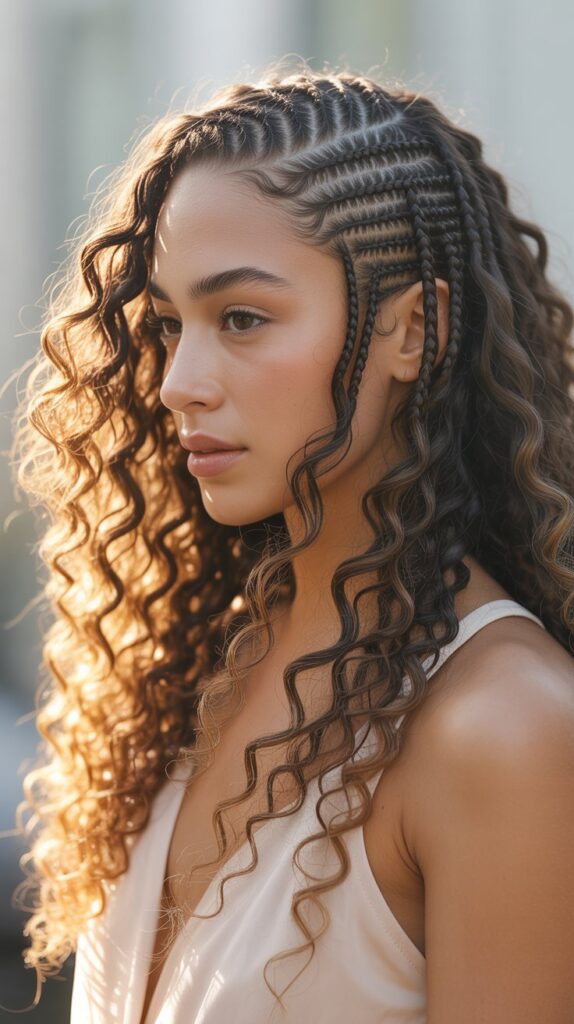
Goddess cornrows combine the sleek appearance of traditional cornrows with the added volume and elegance of curly or wavy hair incorporated throughout the braids.
This romantic style creates a softer, more textured look while maintaining the protective benefits and longevity of cornrow braiding.
Construction technique:
- Curly or wavy extensions are fed into cornrows
- Creates fuller, more voluminous appearance than standard cornrows
- Produces flowing, romantic texture
- Can use pre-curled braiding hair or human hair
- Results in softer, less severe aesthetic
Texture options:
- Loose wave pattern for gentle, flowing movement
- Tight curls for maximum volume and bounce
- Beach wave texture for casual, relaxed vibe
- Spiral curls for defined, springy appearance
- Combination of textures for dimension
Styling benefits:
- Softer appearance than traditional sleek cornrows
- Creates fuller look for children with finer hair
- Adds romantic, feminine element to protective styling
- Photographs beautifully with dimension and movement
- Versatile for both casual and formal occasions
22. Tribal Cornrow Patterns

Tribal cornrow patterns draw inspiration from traditional African braiding designs, featuring bold geometric shapes, symbolic patterns, and culturally significant motifs.
These artistic styles celebrate heritage while creating striking visual statements that honor ancestral braiding traditions passed down through generations.
Common tribal patterns:
- Linear and geometric precision
- Symbolic shapes with cultural meaning
- Asymmetrical designs following traditional aesthetics
- Incorporation of negative space as design element
- Complex interwoven patterns
Cultural education:
- Opportunity to teach children about African heritage
- Discussion of the history and meaning behind patterns
- Connection to specific African ethnic groups and traditions
- Understanding of braiding as cultural art form
- Appreciation for ancestral beauty practices
Pattern symbolism:
- Different designs may represent various concepts
- Geometric shapes can have traditional meanings
- Patterns may indicate social status, age, or community historically
- Contemporary interpretations honor tradition while modernizing
- Wearing these styles connects to ancestral pride
Resources for authentic patterns:
- Research specific ethnic group braiding traditions
- Consult with cultural experts or elder community members
- Reference historical photographs and documentation
- Visit museums featuring African hair art exhibitions
- Connect with professional braiders specializing in traditional styles
23. Cornrow Bob
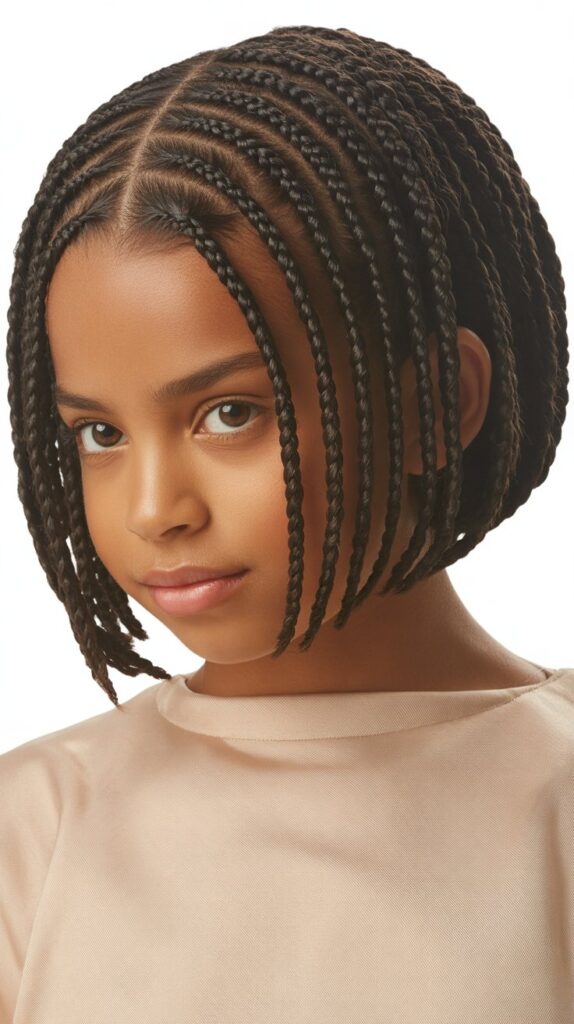
The cornrow bob creates the illusion of a short, chin-length hairstyle while actually protecting longer hair underneath.
This clever styling technique offers a temporary short-hair look without cutting, perfect for children wanting to experiment with different lengths or parents desiring a neater appearance for specific occasions.
Creation method:
- Hair is cornrowed and then folded under and secured
- Creates the appearance of a bob haircut
- Longer hair is protected underneath
- Can be worn for 2-3 weeks typically
- Allows length experimentation without commitment
Style variations:
- Blunt bob line at chin or jaw level
- Angled bob shorter in back, longer in front
- A-line bob with graduated lengths
- Textured ends for casual appearance
- Sleek ends for formal look
Ideal candidates:
- Children curious about short hair but unwilling to cut
- Those with very long hair needing temporary break
- Formal events requiring neater appearance
- Children in environments with strict grooming standards
- Kids wanting to try different looks frequently
24. Mixed Size Cornrows
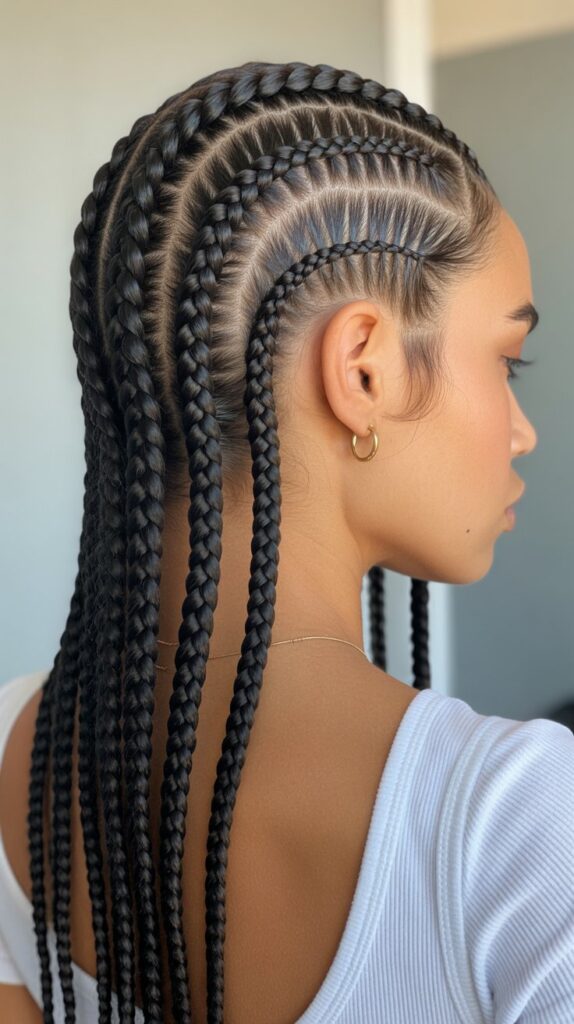
Combining cornrows of varying thicknesses creates dynamic visual interest and texture contrast across the scalp.
This artistic approach breaks from uniform sizing to produce contemporary, fashion-forward styles that showcase creativity while maintaining the protective benefits of cornrowing.
Design strategies:
- Alternate thick and thin rows for striped effect
- Graduate from thin to thick for dimensional appearance
- Feature thick center rows with thin side rows
- Create patterns using size variations strategically
- Frame face with specific sizes for flattering effect
Visual impact:
- Adds depth and dimension to overall appearance
- Creates more interesting photographic qualities
- Breaks monotony of uniform braiding
- Allows for creative artistic expression
- Makes simple patterns look more complex
Technical considerations:
- Requires skill to maintain neat appearance with mixed sizes
- Parting precision becomes more critical
- Installation time may increase with complexity
- Each size may age differently requiring staggered maintenance
- Thicker braids may loosen faster than thin ones
25. Cornrows with Twists

Combining cornrowed sections with two-strand twists creates a hybrid protective style that offers textural variety and extended versatility.
This fusion approach allows for different maintenance schedules and provides the security of braids where needed with the flexibility of twists in other areas.
Common combinations:
- Cornrowed sides and back with twisted top section
- Cornrow base leading into twisted ponytail
- Alternating rows of cornrows and flat twists
- Cornrow perimeter with twisted center area
- Partial cornrows transitioning to free-hanging twists
Maintenance advantages:
- Twists can be redone without disturbing cornrows
- Allows for more frequent style changes
- Cornrows provide security while twists add texture
- Can moisturize twist sections more easily
- Offers flexibility in styling the twisted portions
Styling flexibility:
- Twist sections can be manipulated daily
- Create twist-outs for additional texture
- Bun or updo the twisted portions while cornrows remain
- Add accessories specifically to either section
- Refresh one section without completely restyling
26. Jumbo Cornrows

Jumbo cornrows feature extra-thick braids that create bold, statement-making styles with faster installation times.
These oversized braids work wonderfully for children with thick, dense hair and offer a more relaxed, bohemian aesthetic while still providing excellent protection and longevity.
Size specifications:
- Each braid typically 1-2 inches wide
- Results in 5-10 total cornrows depending on head size
- Creates dramatic, chunky appearance
- Requires significant hair density for best results
- May incorporate extensions for added fullness
Installation benefits:
- Significantly faster than small or standard cornrows (1-3 hours)
- Easier for children to sit through due to shorter time
- Less tension overall despite thick appearance
- Great option for last-minute styling needs
- Simplified maintenance routines
Styling personality:
- Bold, confident, fashion-forward aesthetic
- Casual, bohemian vibe
- Makes strong visual statement
- Perfect for children with big personalities
- Contemporary and trendy appearance
Maintenance simplicity:
- Fewer braids mean easier daily care
- Simple to moisturize scalp between large rows
- Quick edge refreshing process
- Easier to wrap for sleep protection
- Less time-consuming to remove and reinstall
27. Cornrows with Bantu Knots

Finishing cornrows with Bantu knots creates a stunning protective style that combines sleek braiding with sculptural, three-dimensional knots.
This versatile technique allows the cornrowed sections to remain secure while the knots provide textural interest, volume, and the option to unravel them later for beautiful defined curls.
Design configurations:
- Cornrows along sides leading to multiple Bantu knots on top
- Scattered Bantu knots throughout cornrowed sections
- Cornrow base with knots arranged in geometric patterns
- Side cornrows with knots creating a mohawk effect
- Perimeter cornrows framing center section of knots
Bantu knot benefits:
- Creates versatile two-in-one styling option
- Knots can be unraveled for curly texture later
- Adds height and dimension to overall appearance
- Protects hair ends by tucking them securely
- Offers creative arrangement possibilities
Age-appropriate variations:
- Toddlers (2-5 years): 3-6 larger knots for comfort and simplicity
- Elementary (6-10 years): 6-12 medium knots for balanced appearance
- Pre-teens (11-13 years): Multiple small knots for intricate designs
- Keep knot size proportional to child’s head and age
- Consider sitting tolerance when planning knot quantity
Knot placement strategies:
- Crown arrangement for halo effect
- Linear center row for mohawk styling
- Scattered placement for artistic randomness
- Symmetrical sides for balanced appearance
- Concentrated at nape for unique low styling
28. Cornrow Crown with Center Puff
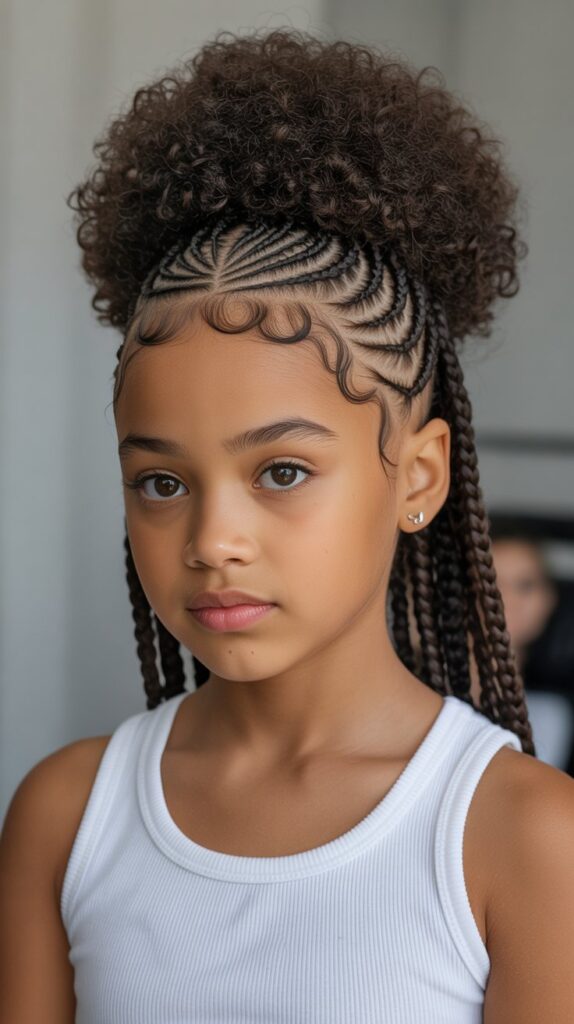
The cornrow crown with center puff creates a regal appearance by braiding around the perimeter while leaving the crown area free for a voluminous natural puff.
This style beautifully showcases natural texture while keeping hair managed around the face and edges, offering the perfect balance of protection and natural hair display.
Construction approach:
- Cornrows circle the head following the hairline
- May be single thick braid or multiple thinner rows
- Center section left unbraided and free
- Puff is shaped and styled at the crown area
- Edges remain sleek while center maintains volume
Puff styling techniques:
- Gather center hair into high puff with elastic band
- Define curls with curl cream or gel
- Pick out for maximum volume and height
- Smooth edges of puff for polished appearance
- Can add decorative elastic or headband at base
Benefits of this hybrid style:
- Showcases beautiful natural curl pattern
- Provides edge protection where tension occurs most
- Allows daily puff restyling without disturbing braids
- Creates height and elongates facial features
- Versatile for both casual and formal occasions
Maintenance routine:
- Refresh puff daily with water and leave-in spray
- Re-gather puff every 2-3 days for neatness
- Moisturize cornrowed sections separately
- Protect puff at night with pineapple method
- Refresh cornrow edges weekly
29. Ladder Braid Cornrows
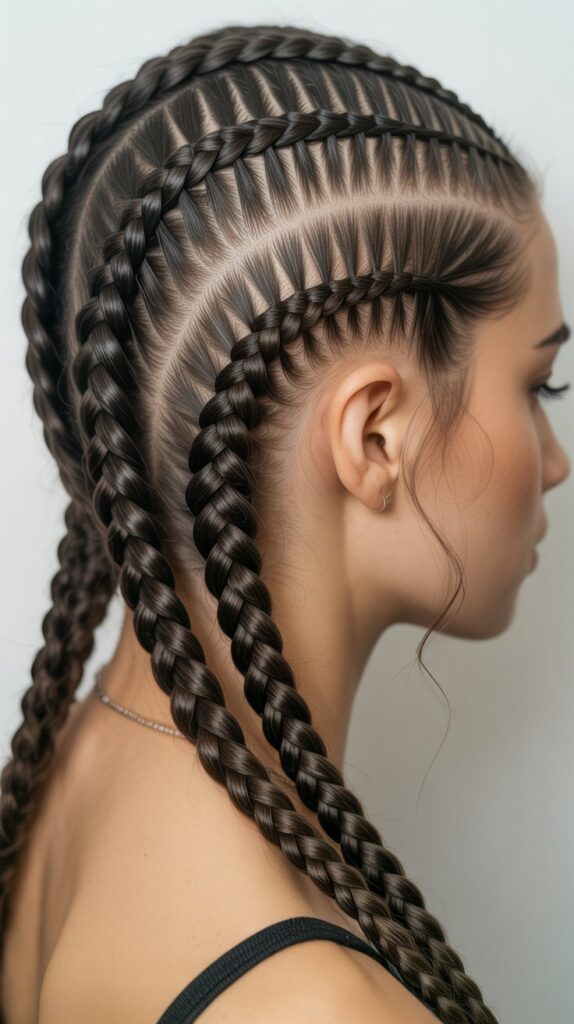
Ladder braid cornrows create a distinctive woven appearance by incorporating horizontal connections between parallel vertical braids, resembling the rungs of a ladder.
This intricate technique produces a unique basketweave effect that elevates traditional cornrowing into a true art form, perfect for children attending special events or wanting standout styles.
Technical construction:
- Two or more parallel cornrows are braided vertically
- Horizontal sections connect the vertical braids at intervals
- Creates ladder-like rungs between the main braids
- Requires advanced braiding skills and precision
- Best executed by professional stylists
Visual characteristics:
- Produces striking geometric pattern
- Creates dimensional, textured appearance
- Highlights technical braiding expertise
- Photographs exceptionally well from all angles
- Makes even simple two-braid designs look complex
Complexity levels:
- Beginner: Two parallel braids with 3-4 ladder rungs
- Intermediate: Three braids with 5-6 evenly spaced rungs
- Advanced: Multiple braids with intricate rung patterns
- Can incorporate curved paths instead of straight lines
- May combine with other cornrow techniques
Installation time:
- Simple ladder design: 2-3 hours
- Complex multiple ladder patterns: 4-6 hours
- Requires patience from both stylist and child
- Best scheduled when child is well-rested and fed
- Consider breaking into multiple sessions if needed
30. Cornrows with Colored Extensions

Incorporating vibrant colored extensions into cornrows allows children to experiment with bold, eye-catching hues without permanent hair dye or chemical processing.
This temporary color option provides creative expression, trendy styling, and the excitement of transformation while maintaining hair health and allowing easy return to natural color.
Popular color choices:
- Bright primary colors: Red, blue, yellow for bold statements
- Pastels: Pink, lavender, mint for softer aesthetic
- Neons: Electric colors for maximum visibility and fun
- Ombre effects: Gradual color transitions for sophistication
- Multi-color: Rainbow or multiple hues for playful diversity
Color placement strategies:
- Full head of single color for dramatic transformation
- Accent braids with color among natural braids
- Ombre effect from roots to tips
- Alternating colored and natural braids for striped effect
- Color concentrated at ends for subtle pop
Selecting appropriate colors:
- Consider child’s personality and preferences
- Verify school dress code policies on hair color
- Choose skin-tone flattering shades
- Think about occasion appropriateness
- Select quality synthetic hair that won’t fade or bleed
Extension color care:
- Colored synthetic hair shouldn’t be exposed to excessive heat
- Avoid chlorine which can alter or fade colors
- Protect from prolonged direct sunlight exposure
- Be cautious with light-colored clothing to prevent dye transfer
- Quality extensions maintain color better throughout wear
Psychological benefits:
- Allows safe self-expression and creativity
- Builds confidence through appearance control
- Provides temporary change without commitment
- Creates excitement and positive attention
- Teaches about temporary versus permanent decisions
Styling and Maintenance Tips for Cornrow Hairstyles

Proper care and maintenance are essential for keeping children’s cornrows looking fresh, protecting natural hair health, and maximizing the longevity of these protective styles.
Daily maintenance routine:
- Spray braids lightly with water and leave-in conditioner mixture each morning
- Apply lightweight oil directly to scalp between cornrows using applicator bottle
- Gently massage scalp with fingertips to stimulate circulation
- Check for any loosening braids and address promptly
- Wipe away any product buildup around hairline
Nighttime protection:
- Cover cornrows with satin or silk bonnet before sleep
- Alternatively, use satin or silk pillowcase
- For styles with loose ends, consider pineapple method
- Ensure bonnet fits properly without being too tight
- Replace worn bonnets that no longer stay secure
Weekly maintenance tasks:
- Deep cleanse scalp with diluted shampoo on cotton pad or applicator bottle
- Refresh edges with gentle styling gel or edge control
- Inspect all braids for signs of excessive loosening
- Apply heavier moisturizing treatment to scalp
- Check for any irritation or tension issues
Products to use:
- Lightweight leave-in conditioner sprays
- Non-greasy oils like jojoba, grapeseed, or argan
- Alcohol-free edge control or styling gel
- Dry shampoo or witch hazel for scalp cleansing
- Braid spray specifically formulated for braided styles
Products to avoid:
- Heavy creams and butters that cause buildup
- Petroleum-based products that attract dirt
- Alcohol-heavy products that cause dryness
- Anything causing white flaking or residue
- Fragranced products if child has sensitive skin
Longevity tips:
- Most cornrow styles last 2-4 weeks with proper care
- Feed-in and smaller braids typically last longer
- Remove and reinstall before braids become too loose
- Never leave protective styles in beyond 6-8 weeks
- Schedule removal and hair rest period between installations
Safe removal process:
- Never leave cornrows in until they’re severely matted
- Apply oil generously before beginning removal
- Carefully unravel each braid starting from the ends
- Use fingers rather than combs initially
- Be patient and gentle to prevent breakage
- Detangle thoroughly after complete removal
- Deep condition hair after removal
- Allow hair to rest at least 1-2 weeks before reinstalling
Health Considerations for Children’s Cornrows

Understanding the health aspects of cornrowing ensures that protective styling enhances rather than damages children’s delicate developing hair and scalp.
Scalp health priorities:
- Children’s scalps are more sensitive than adult scalps
- Growing hair follicles need proper care and circulation
- Excessive tension can cause permanent follicle damage
- Regular scalp inspection prevents issues from worsening
- Healthy scalp equals healthy hair growth
Tension awareness:
- Cornrows should never cause pain during or after installation
- If child complains of discomfort, braids are too tight
- Bumps along braids indicate excessive tension
- Headaches following installation signal problem
- Proper tension feels secure but comfortable
Signs of traction alopecia:
- Small bumps or pimples along hairline
- Thinning or missing hair at edges or temples
- Shiny, smooth areas where hair once grew
- Tender spots when touching scalp
- Hair not growing back after style removal
Prevention strategies:
- Use feed-in technique to reduce starting tension
- Avoid pulling edges back tightly repeatedly
- Vary part placement with each installation
- Limit protective styling to 4-6 week periods
- Allow rest periods between styled phases
- Choose age-appropriate, lighter styles
When to remove cornrows immediately:
- Child consistently complains of pain or discomfort
- Visible swelling or irritation on scalp
- Bumps, sores, or infections developing
- Excessive hair shedding or breakage visible
- Edge thinning becomes noticeable
- Style has been in longer than 6 weeks
Consulting professionals:
- Pediatric dermatologists for scalp concerns
- Licensed cosmetologists with natural hair expertise
- Trichologists for hair and scalp health issues
- Cultural hair care specialists familiar with protective styling
- Online communities for shared experiences and advice
Age-appropriate considerations:
- Toddlers (2-5 years): Simple, quick styles with minimal tension
- Young children (6-10 years): Moderate complexity, comfortable sitting time
- Pre-teens (11-13 years): More elaborate styles with proper care education
- Always prioritize child’s comfort over style complexity
- Teach older children to recognize and report discomfort
Building healthy hair habits:
- Educate children about proper hair care from young age
- Teach them to speak up about discomfort immediately
- Involve them in gentle maintenance routines
- Explain the “why” behind protective styling
- Celebrate their natural hair in all forms
Conclusion
The journey through these 30 Best Cornrow Hairstyles for Kids with Natural Hair reveals the incredible diversity, cultural richness, and protective benefits that cornrow braiding offers children today.
From timeless classics like straight-back cornrows that have stood the test of time to contemporary innovations like stitch braids and colored extensions, each style serves the dual purpose of celebrating natural hair texture while safeguarding its health and promoting growth.
These versatile protective hairstyles empower parents with practical, long-lasting options that minimize daily styling stress while giving children the confidence that comes from looking and feeling their best.
Whether you choose simple designs for active toddlers, intricate patterns for special occasions, or bold creative expressions that showcase individuality, cornrows provide a canvas for both cultural connection and personal style.
The key to success lies in prioritizing hair health through proper tension, consistent maintenance, and age-appropriate styling choices that respect the delicate nature of developing hair follicles.
By embracing these beautiful cornrow variations, you’re not only choosing a practical hairstyle solution but also participating in a rich cultural tradition that has been passed down through generations, teaching children to appreciate and honor their natural hair while exploring the endless creative possibilities it offers.
Remember that the most beautiful cornrow style is always the one that keeps your child comfortable, confident, and connected to their unique identity, making every day an opportunity to celebrate the natural beauty of textured hair through the timeless art of braiding.
